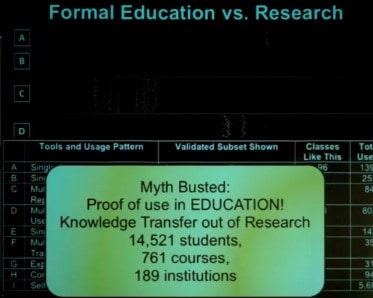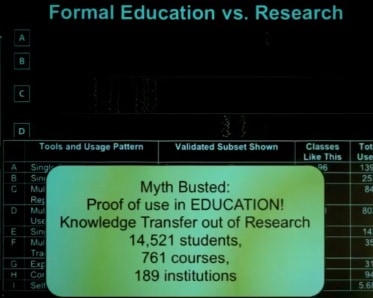
A select set of videos from the 2013 Foresight Technical Conference: Illuminating Atomic Precision, held January 11-13, 2013 in Palo Alto, have been made available on vimeo. Videos have been posted of those presentations for which the speakers have consented. Other presentations contained confidential information and will not be posted.
The fifth speaker at the Computation and Molecular Nanotechnolgies session, Gerhard Klimeck, presented “Mythbusting Knowledge Transfer Mechanisms through Science Gateways” . https://vimeo.com/62119946 – video length 40:28. Prof. Klimeck addressed novel ways to disseminate nanotechnology simulations to broader audiences using as an example a user facility, the web site nanoHUB. About 12,000 users sign up for accounts and run half a million simulations throughout the year. Even more people view lectures, seminars, tutorials, for which no account is needed. Looking at a display of the use of the facility from day to day, Prof. Klimeck asked whether the bursts of activity that appear show signs of knowledge transfer happening. Some of this data illustrates the mythbusting over the past ten years—all the things we were told we could not do. For example, the facility used to have about a thousand users per year, and then the tools were made interactive and suddenly that grew to about 12,000 today. Lectures and seminars were introduced and led to dramatic growth. Citing recent interest in MOOCs (massive open online course), Prof. Klimeck noted that they had been a MOOC for a number of years.
Prof. Klimeck shared a video about nanoHUB that illustrated the real research tools that are available as simulations users can run, for example, nanopores and quantum dots. He emphasized that the facility is completely free.
Looking back to 1965 and the advent of Moore’s Law, Prof. Klimeck pointed out that the enormous technological and economic progress embodied in Moore’s Law arose in part due to two pieces of software: Berkeley SPICE and Stanford SUPREM, used for circuit simulation and device processing. What is not generally recognized, Prof. Klimeck notes, is that SPICE started with a teaching tool. It was created in graduate school to teach about circuits. The creators continued to develop it by giving tapes of the program to students and inviting them to break the program so they could fix it. They knew that software is never perfect and they invited user participation. Other tools that existed at the same time were kept proprietary and thus no one knows their names anymore, but Simulation Program with Integrated Circuit Emphasis revolutionized the world. Similarly the Stanford University PRocEss Modeling tool started out as research tool that students took along with them to industry.Those teo tools generated a new industry, said Prof. Klimeck, noting that Intel has a capitalization of $85B, an the total industry of $ 280B.
Inspired by the benefits created by SPICE and SUPREM, Prof. Klimeck asked what benefits nanotechnology research can create for the world. “How do you get stuff out of this cornucopia of research and make it useful?”
To illustrate what anyone can do today using nanoHUB, Prof. Klimeck showed a molecular dynamics animation of carbon nanotubes and an animation of the eigenstates of quantum dots. The free availability of these simulations means they are available to experimentalists, and they can vet the tools so they can be improved. But can these tools rapidly be migrated to education, and can this migration have economic impact?
Although a gateway like nanoHUB need not be specific to nanotechnology, Prof. Klimeck said he was unaware of any other science gateways that have had an impact comparable to that of nanoHUB. Focusing on why it has proven difficult to replicated the success of nanoHUB, Prof. Klimeck noted that the whole process of placing things on the web is very difficult. One problem is that most code is written by one person tobe used by that same person, so the code is very user unfriendly—it tends to appears as gobbledygook to anyone except the person who wrote it. In addition to being ‘user friendly’, the code must be ‘developer friendly’.It must be easy to make interfaces and put simulations out for the community to try. Finally the code has to be accessible, so someone has to operate the facility to allow people to use the code.
Bringing these three stakeholders—users, developers, and facility operators—together has been difficult, in part because of myths that have developed. Prof. Klimeck related that he has been told in no uncertain terms that codes must be rewritten to use them for education, or that you must rewrite your whole code to put it on the web, or you must write your own code to do research, that is, you must understand every line of code to reuse someone else’s code.
Prof. Klimeck considered the case of a researcher with a cool code useful for some scientific question, so he writes a proposal to put the code on the web by hiring a web developed who speaks a different language to put the code ont he web. The process typically takes 2-3 years to rewrite the code, but what researcher wants to not modify his code for 2-3 years during this process? So the researcher is frustrated because he is answering questions from the person rewriting the code, he no longer trusts the code, money is being spent, and no new research is getting done. Thus people conclude that such a web site cannot be used for real research—they can only be toy applications that perhaps can be used for education, but not for deep research.
nanoHUB is different, Prof. Klimeck explained, because they eliminated the middle person, and did publish 175 tools in 4 years. There is no code rewrite; the researcher retains ownership of the code, and this process only takes one or two weeks instead of two or three years. To make this possible, nanoHUB supplies a whole software ecosystem very similar to Linux that is easy to learn. This system has produced hundreds of tools and formed developer networks, producing small collaborations that can end up serving thousands of users, and helping some researchers procure early promotions through their involvement in nanoHUB.
As to the use of nanoHUB in education, Prof. Klimeck showed that knowledge transfer out of research and into education involved 14,521 students, taking 761 courses, in 189 institutions. Another interesting statistic her presented was that more than half of the tools coming out of research were adopted in classrooms in less than 6 months. Further there were 960 citations of these tools in the literature, proving that other researchers were indeed using the tools that researchers had placed on nanoHUB. Further, as with SPICE and SUPREM, many of the tools on nanoHUB find dual use in research and in education.
—James Lewis, PhD


